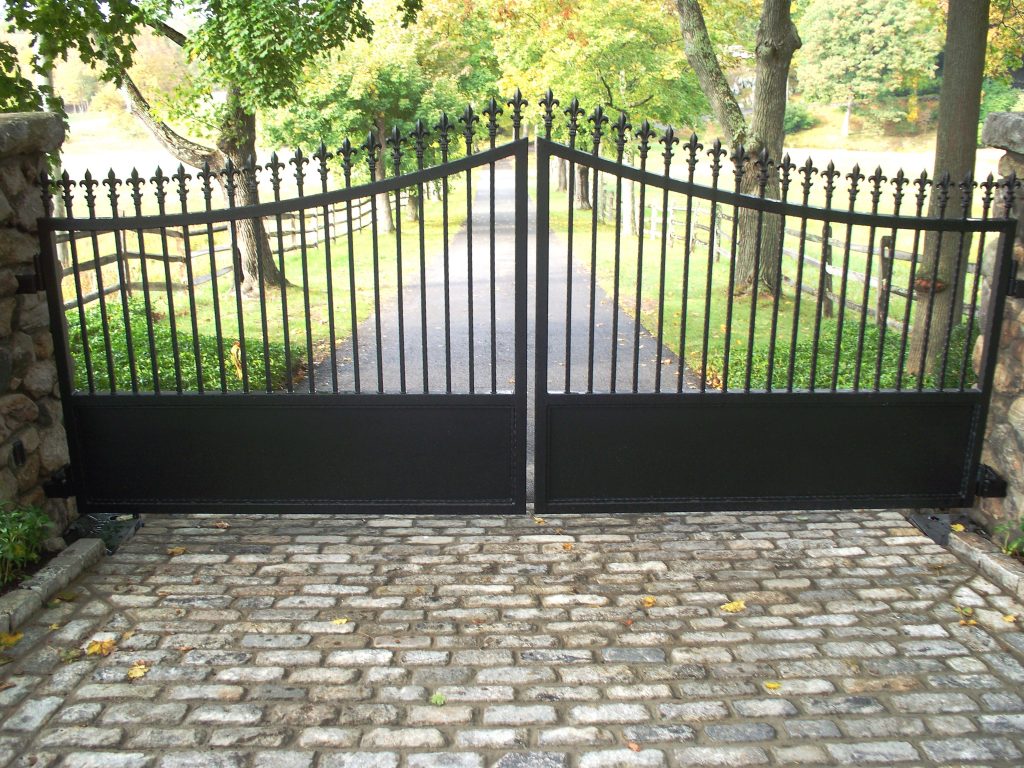
Automatic gates are often seen as a sign that a residential property is more sophisticated and expensive than others. Going by the fact that the minimum cost for installing an automatic gate is approximately $3,000 and the average national cost at $7,000, at least one of these assertions is correct.
But how do automatic gates work? What are the different types of automatic gates? And what other parts do they have?
How Do Automatic Gates Work?
At its core, an automatic gate works by using an electric motor to work the mechanism of a gate to open and shut. Aside from the tantalizing amount of designs and materials available, there are multiple variances for this relatively straightforward arrangement.
For example, automatic gates can work on sensors that detect an approaching vehicle and activate the opening mechanism accordingly. Others work through remote-controlled gate openers, not unlike the type that opens automated garage doors. These devices are most commonly dependent on radio frequencies to communicate with the automatic gate’s activation mechanisms.
Depending on the terrain, automatic gates may work by rolling along the ground on rubberized wheels. Others work on deeply incised tracks through which the gate rolls back and forth. Others work by using mounted rails to obviate the necessity of tracks or wheels. These all depend on the type of gate installed on the property.
What Are the Types of Automatic Gates?
There are many types of automatic gates. Some are more suited for commercial properties than residential. Others are more appropriate for different types of terrain, as they may interfere with their activation mechanisms.
Below are some of the most common types of automatic gate designs.
Slide Gates
This is one of the most common types of automatic gates. The gate’s opening motor is installed on a nearby wall and the gate itself slides open to the side when activated. The gate may be assisted by rubberized wheels or pulled along a deep track cut into the pavement. These types of gates can be easily blocked by debris. Rocks and snow may choke a track or impede the process of the wheels.
Swinging Gates
Swinging gates open via a motor attached to a hinge mechanism, similar to how a door swings open and shuts. These types of gates are among the most affordable automatic gates because they don’t need a full wall for support. However, swinging gates require a lot of room to maneuver while opening. Safety measures must be put in place to prevent cars of people from getting caught in the gate’s arc.
Cantilever Gates
Unlike sliding gates, cantilever gates don’t need tracks or wheels on the ground to open. Instead, the gate travels along a raised rail embedded on the wall supporting the motor and opening mechanism. This type of gate requires more space and construction because the gate requires a lot of walls, both to anchor the cantilever’s rails and to balance its weight. The sides of a driveway must be free from obstruction on either side to allow the wall’s construction.
Pivot Gates
Pivot gates operate by vertically lifting the gate, like the arm gates on parking garages. The support for this type of gate is entirely reliant on its operating mechanism rather than a motor embedded on the wall. It uses up less space than other types. However, pivot gates require a heavier and larger footprint. Their opening mechanisms also tend to be more complicated because they use counterweight systems to activate.
Folding Gates
Folding gates usually have two gate panels with two hinge portions each, although some may have more than this. The gate opens by retreating along a track placed above it or cut into the pavement, folding back to allow access. Folding gates require less space than other automatic gates, however, they present plenty of dangers for mechanical entrapment accidents.
What Are Other Components of Automatic Gates?
Automatic gates have more components than the gate, activation sensor, and electric motors. The following are some of the components automatic gates require, although this may depend on the type of gate in question.
Posts
Support posts are needed by pivoting gates or by folding gates. The posts act as anchors for their opening mechanisms. Other types of gates may use them as support for their motors or to increase the range of their radio sensors.
Walls
Gates act as the support structure for the motors and rails of multiple types of gates such as cantilever gates and sliding gates. More than that, they’re essential in preventing an automatic gate from simply being decorative, as they stop trespassers from simply walking into your property.
Intercom
Some automatic gates use an intercom system to allow residents to communicate with anyone who wants access to the property. Some intercom systems are simply an audio receiver and transmitter, more elaborate ones have video feeds or even facial recognition software to act as a secondary security system.
Automatic gates are a status symbol among properties. But their hefty price tag can be a hindrance for people who want to install them on their homes. Learning more about how they work and your options can help determine the ideal choice for any property.